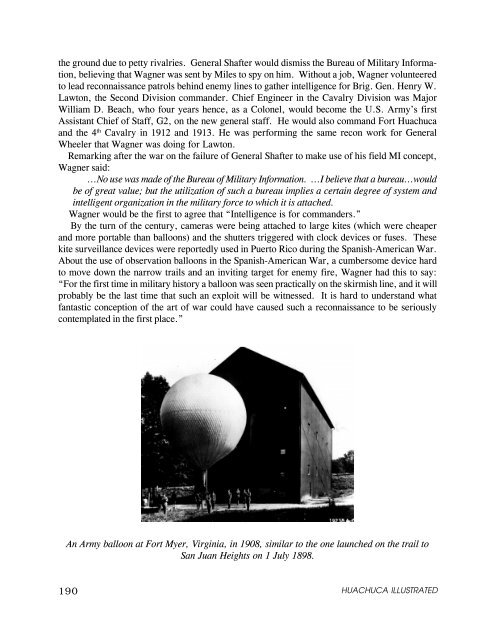Turn of the Century - Fort Huachuca - U.S. Army
Turn of the Century - Fort Huachuca - U.S. Army
Turn of the Century - Fort Huachuca - U.S. Army
- No tags were found...
Create successful ePaper yourself
Turn your PDF publications into a flip-book with our unique Google optimized e-Paper software.
<strong>the</strong> ground due to petty rivalries. General Shafter would dismiss <strong>the</strong> Bureau <strong>of</strong> Military Information,believing that Wagner was sent by Miles to spy on him. Without a job, Wagner volunteeredto lead reconnaissance patrols behind enemy lines to ga<strong>the</strong>r intelligence for Brig. Gen. Henry W.Lawton, <strong>the</strong> Second Division commander. Chief Engineer in <strong>the</strong> Cavalry Division was MajorWilliam D. Beach, who four years hence, as a Colonel, would become <strong>the</strong> U.S. <strong>Army</strong>’s firstAssistant Chief <strong>of</strong> Staff, G2, on <strong>the</strong> new general staff. He would also command <strong>Fort</strong> <strong>Huachuca</strong>and <strong>the</strong> 4 th Cavalry in 1912 and 1913. He was performing <strong>the</strong> same recon work for GeneralWheeler that Wagner was doing for Lawton.Remarking after <strong>the</strong> war on <strong>the</strong> failure <strong>of</strong> General Shafter to make use <strong>of</strong> his field MI concept,Wagner said:...No use was made <strong>of</strong> <strong>the</strong> Bureau <strong>of</strong> Military Information. ...I believe that a bureau...wouldbe <strong>of</strong> great value; but <strong>the</strong> utilization <strong>of</strong> such a bureau implies a certain degree <strong>of</strong> system andintelligent organization in <strong>the</strong> military force to which it is attached.Wagner would be <strong>the</strong> first to agree that “Intelligence is for commanders.”By <strong>the</strong> turn <strong>of</strong> <strong>the</strong> century, cameras were being attached to large kites (which were cheaperand more portable than balloons) and <strong>the</strong> shutters triggered with clock devices or fuses. Thesekite surveillance devices were reportedly used in Puerto Rico during <strong>the</strong> Spanish-American War.About <strong>the</strong> use <strong>of</strong> observation balloons in <strong>the</strong> Spanish-American War, a cumbersome device hardto move down <strong>the</strong> narrow trails and an inviting target for enemy fire, Wagner had this to say:“For <strong>the</strong> first time in military history a balloon was seen practically on <strong>the</strong> skirmish line, and it willprobably be <strong>the</strong> last time that such an exploit will be witnessed. It is hard to understand whatfantastic conception <strong>of</strong> <strong>the</strong> art <strong>of</strong> war could have caused such a reconnaissance to be seriouslycontemplated in <strong>the</strong> first place.”An <strong>Army</strong> balloon at <strong>Fort</strong> Myer, Virginia, in 1908, similar to <strong>the</strong> one launched on <strong>the</strong> trail toSan Juan Heights on 1 July 1898.190 HUACHUCA ILLUSTRATED
















